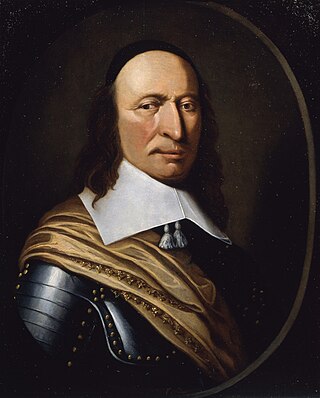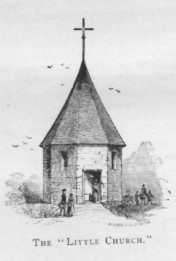
New Amsterdam was a 17th-century Dutch settlement established at the southern tip of Manhattan Island that served as the seat of the colonial government in New Netherland. The initial trading factory gave rise to the settlement around Fort Amsterdam. The fort was situated on the strategic southern tip of the island of Manhattan and was meant to defend the fur trade operations of the Dutch West India Company in the North River. In 1624, it became a provincial extension of the Dutch Republic and was designated as the capital of the province in 1625. New Amsterdam became a city when it received municipal rights on February 2, 1653.

Peter Stuyvesant was a Dutch colonial officer who served as the last Dutch director-general of the colony of New Netherland from 1647 until it was ceded provisionally to the English in 1664, after which it was split into New York and New Jersey with lesser territory becoming parts of other colonies, and later, states. He was a major figure in the early history of New York City and his name has been given to various landmarks and points of interest throughout the city.

New Netherland was a 17th-century colonial province of the Dutch Republic located on the east coast of what is now the United States of America. The claimed territories extended from the Delmarva Peninsula to Cape Cod. Settlements were established in what became the states of New York, New Jersey, Delaware, and Connecticut, with small outposts in Pennsylvania and Rhode Island.

The Netherlands began its colonization of the Americas with the establishment of trading posts and plantations, which preceded the much wider known colonization activities of the Dutch in Asia. While the first Dutch fort in Asia was built in 1600 in present-day Indonesia, the first forts and settlements along the Essequibo River in Guyana date from the 1590s. Actual colonization, with the Dutch settling in the new lands, was not as common as by other European nations.

Willem Kieft, also Wilhelm Kieft, was a Dutch merchant and the Director of New Netherland from 1638 to 1647.
This is a list of Directors, appointed by the Dutch West India Company, of the 17th century Dutch province of New Netherland in North America. Only the last, Peter Stuyvesant, held the title of Director General. As the colony grew, citizens advisory boards – known as the Twelve Men, Eight Men, and Nine Men – exerted more influence on the director and thus affairs of province.
Abraham Pietersen van Deursen, aka Abraham Pietersen van Deusen, was an immigrant from Holland who settled in New Amsterdam and become one of the Council of 12 that was the first representative democracy in the Dutch colony. The Van Deursen, Van Deusen, Van Duser, Van Duzer, Van Duzor, Van Duzee, and Van Dusen families of the United States and Canada are all descended from Abraham Pietersen van Deusen, a miller and a native originating from Haarlem in the Netherlands.
The Twelve Men was a council of citizens chosen by the residents of New Netherland to advise Director Willem Kieft on relations with the Native Americans in the wake of the murder of Claes Swits. Elected on 29 August 1641, the temporary council was the first representational form of democracy in the Dutch colony. The next two such bodies were known as the Eight Men and the Nine Men.

Rensselaerswyck was a Dutch colonial patroonship and later an English manor owned by the van Rensselaer family located in the present-day Capital District of New York in the United States.

Adriaen Cornelissen van der Donck was a lawyer and landowner in New Netherland after whose honorific Jonkheer the city of Yonkers, New York, is named. Although he was not, as sometimes claimed, the first lawyer in the Dutch colony, Van der Donck was a leader in the political life of New Amsterdam, and an activist for Dutch-style republican government in the Dutch West India Company-run trading post.
The Eight Men was a group of eight residents chosen by the people of New Netherland in 1643 to advise Director Willem Kieft on his governance of the colony. An early form of representational democracy in colonial North America, it replaced the similarly selected Twelve Men and was followed by the Nine Men.

Kieft's War (1643–1645), also known as the Wappinger War, was a conflict between the colonial province of New Netherland and the Wappinger and Lenape Indians in what is now New York and New Jersey. It is named for Director-General of New Netherland Willem Kieft, who had ordered an attack without the approval of his advisory council and against the wishes of the colonists. Dutch colonists attacked Lenape camps and massacred the inhabitants, which encouraged unification among the regional Algonquian tribes against the Dutch and precipitated waves of attacks on both sides. This was one of the earliest conflicts between settlers and Indians in the region. The Dutch West India Company was displeased with Kieft and recalled him, but he died in a shipwreck while returning to the Netherlands; Peter Stuyvesant succeeded him in New Netherland. Numerous Dutch settlers returned to the Netherlands because of the continuing threat from the Algonquians, and growth slowed in the colony.
Walling Jocobse Van Winkle (1650–1725) was an early settler of the Northern New Jersey area and the namesake for the town of Wallington, New Jersey, where he had built a home.

Zwaanendael or Swaanendael was a short-lived Dutch colonial settlement in Delaware. It was built in 1631. The name is archaic Dutch for "swan valley." The site of the settlement later became the town of Lewes, Delaware.
Cornelis Melyn was an early Dutch settler in New Netherland and Patroon of Staten Island. He was the chairman of the council of eight men, which was a part of early steps toward representative democracy in the Dutch colony.

New Netherlanders were residents of New Netherland, the seventeenth-century colonial outpost of the Republic of the Seven United Netherlands on the northeastern coast of North America, centered on the Hudson River and New York Bay, and in the Delaware Valley.

Jan Evertsz Bout, was an early and prominent Dutch settler in the 17th century colonial province of New Netherland.

Voorleser was the title given to a highly responsible citizen in New Netherland and later Dutch colonies, who had semi-official duties in local law, education and religion.

Jochem Pietersen Kuyter was an early colonist to New Netherland, and one of the first settlers of what would become Harlem on the island of Manhattan. He became an influential member of the community and served on the citizen boards known as the Twelve Men, the Eight Men and the Nine Men.











